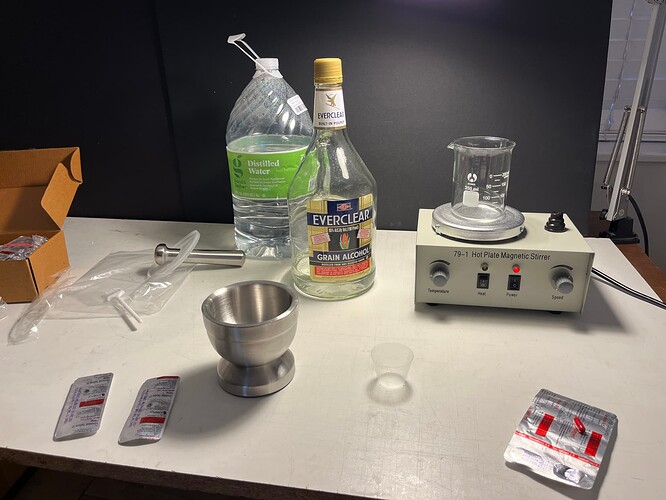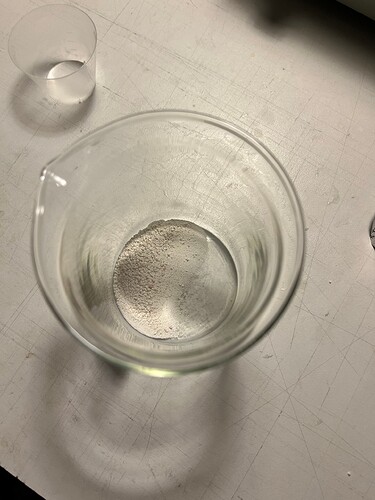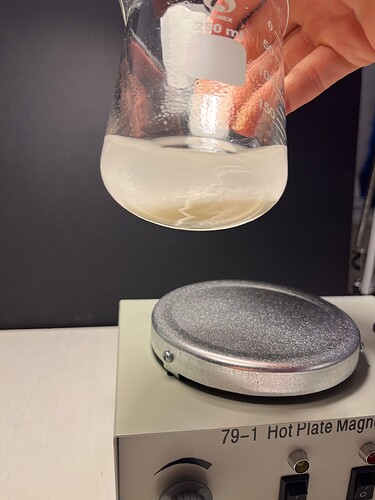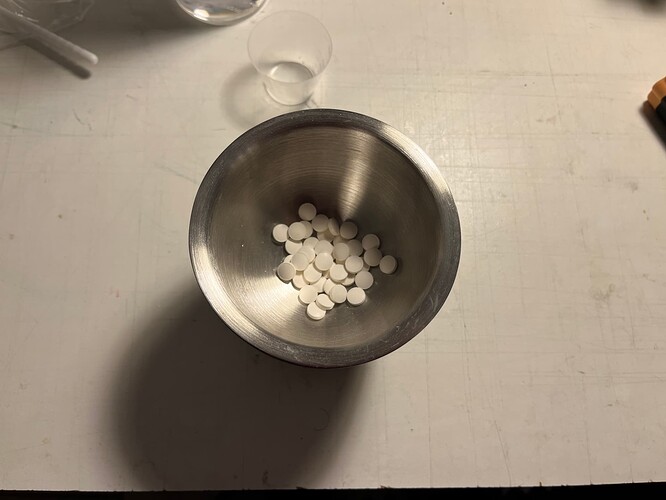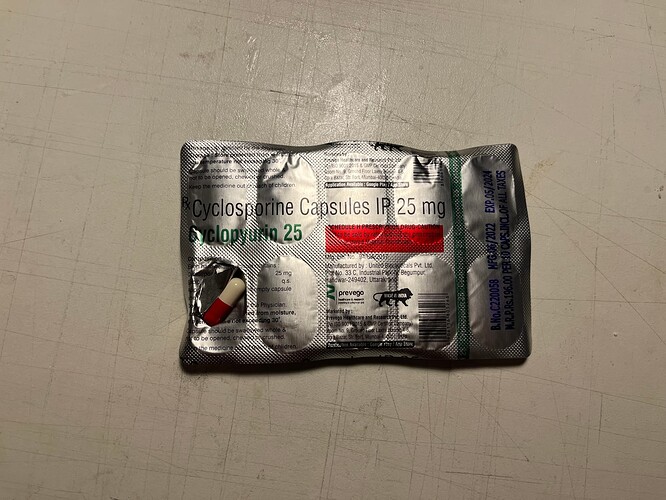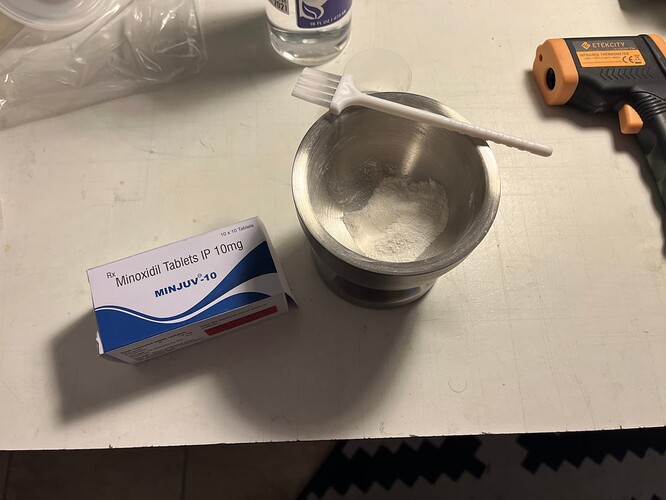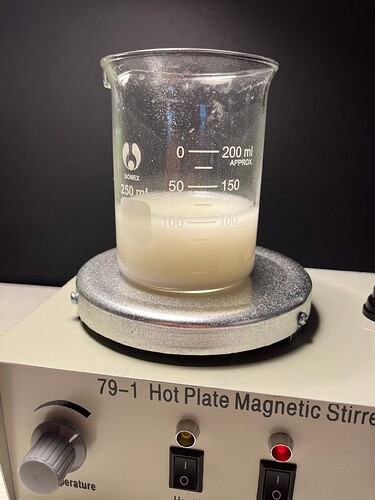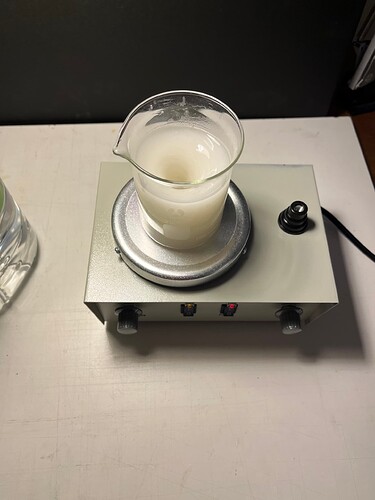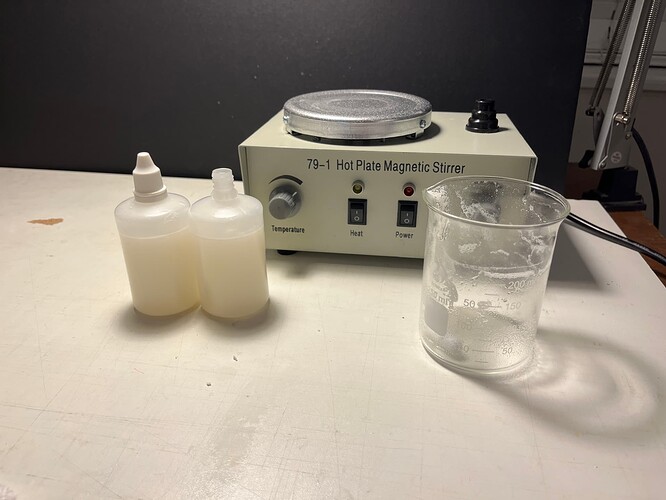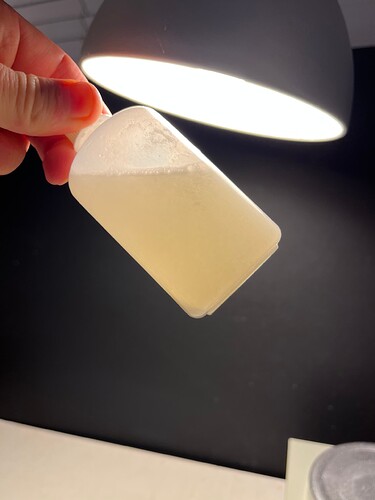My large Kachela order went through just fine, arriving 12 days after they shipped.
I finally received all the components for this so was able to make a DIY Rivertown mixture. This is a step by step description of my first attempt.
First, start with what quantity of solution you’re going to make and calculate the number of pills needed to reach a certain concentration. I made a 2% minoxidil solution instead of the 5% used in the paper. The other components have the same concentration. This example shows the amount needed for 100 ml of solution. In the photos below I made 200 ml of solution, so I doubled the quantities.
Here we see that we need 5 pills of both cyclosporine and tacrolimus and 20 tablets of minoxidil based on the milligrams of each drug in each pill. The liquid components were 50:30:20 of water:ethanol:proylene glycol. EDIT: I realized later that I mixed up the quantity of water and PG, it should be 50:30:20 propylene glycol:ethanol:H2O.
I purchased a magnetic stirring hot plate to help aid in making the solution. I mixed things in a 200 ml beaker. Here’s a photo of what I started with (propylene gylocol not shown)
Both the cyclosporine and tacrolimus came in separable capsules and were a white powder. Some of the product descriptions of the cyclosporine suggested they were liquid, or gel caps, but this wasn’t the case. Here is a photo of the tacrolimus after emptying the capsules into the beaker. I did not re-crush them using the mortar and pestle but probably will for a future batch:
While the info on the binder material, magnesium stearate indicated that it was somewhat soluble in hot ethanol, I found that it did not totally dissolve. It may also be a function of the ratio of magnesium stearate to ethanol. Here’s a photo of the beaker after ethanol heated to boiling (70-75C) and stirred for several minutes. There is still a fair amount of undissolved material at the bottom of the beaker:
Next I added the minoxidil tablets and separated cyclosporine to the mortar and pestle to crush into powder. I assume the binder material for these is magnesium stearate as well, so that probably did not help the overall amount of undissolved material at the end:
post crush:
I attempted to dissolve all the powder in the ethanol + tacrolimus, but it unsurprisingly did not work:
Finally I just added the other liquid ingredients to the mixture and heated it a bit and continued to stir for another 5-10 minutes.
I bottled the mixture stirring frequently to get an even amount into each bottle before the solids could settle.
After letting the bottles sit for a while, the undissolved material settled to the bottom.
When I apply the solution, I’m sure to shake the mixture so that the undissolved material makes it out of the bottle. I do not know if this lowers the effectiveness or not (or if so by how much), but it’s the best I can come up with at present. Ideally we would be able to use pure powders of each drug type to reach the desired concentration with full dissolution of the components, but I’m not sure the availability of each from quality sources. I have not had any skin irritation from the solution after using it for about three days. With the dropper bottle tip, I can put it against the scalp directly on the roots.
After not hearing anything from them for 2.5 weeks, Kachhela sent a replacement shipment for the one that was confiscated. I may just have been unlucky the first time when it was confiscated. TBD if the replacement shipment will be confiscated or not.
Here are the dropper bottles I used. The true capacity is probably more like 150 ml.
Stirrer:
Awesome post! Thanks so much.
Really interested in hearing about your results. Keep us up-to-date.
I still don’t understand why people are using both tacrolimus and cyclosporin together, that doesn’t make sense as both are calcineurin inhibitors. I can say that tacrolimus alone doesn’t work though but minoxidil alone is known to recolor hair. So I would try minoxidil and minoxidil + tacrolimus first on one half of the face.
Thanks for sharing your process with so detailed step-by-step guide and pictures, I think we all met the same problem of incompletely dissolved tacrolimus capsule, it looks like the heating can’t dissolve tacrolimus capsule too, I don’t know if the precipitation is tacrolimus itself or the drug fillers.
Tacrolimus is soluble in DMSO (20 mg/ml), ethanol (30 mg/ml), the pure tacrolimus should be easily dissolved in ethanol, I will try to use ultrasonic machine to dissolve tacrolimus capsule in the ethanol, however I don’t expect I will success.
I found there are people selling pure tacrolimus powder on the IndiaMart, maybe we should try to use tracolimus powder next time?
I agree, it’s tough to know how much of each active ingredient is being dissolved given the large amount of precipitate. If I had to guess, I would say that what we’re seeing is mostly binder material, and it may not be just from tacrolimus.
I just quickly weighed one of the 10 mg minoxidil tablets and it was 180 mg, meaning 170 mg is binder. For 20 tablets needed to make a 2% minoxidil base, that’s 3.4 g of binder, which is a lot. If you wanted to truly follow the paper and use 5% minoxidil, that would be 8.5 g of binder. Of course, we don’t know if or how much of each active ingredient is still bound in the binder, leading to inaccuracy in reaching the desired concentration.
Good call on checking IndiaMart for pure powder. I haven’t looked at that. I would probably try that next, though I would wonder about the quality. We would probably need all the components in powder form, not just the tacrolimus for best results. We would probably also want to create a larger volume of solution in one mix to increase the accuracy of weighing out the correct amount for each component. The amount of tacrolimus for example would need to be 2.4 mg for 100 ml of solution, whereas a 500 ml solution would need 12 mg, or 24 mg for 1000 ml, which is a more reasonable amount to accurately weigh using a cheap scale. Ideally, we’d all have access to analytical balances!
I know that Melissa Harris is aware of this thread, maybe you can ask her for advice?
How do you know? Did you talk with her? When I get a chance I’ll try to reach out to her. It would be interesting to talk with her and follow her research.
By people do you mean people reading/participating in this thread, or the authors of the study? I think readers here are basing their assumptions on the results of the paper rather than having a deep understanding of the biology. I am not a biologist so am going with the paper.
The full text of the paper contains some discussion regarding the use of cyclosporine and tacrolimus. The authors address the selection of RT175, the tacrolimus derivative, as well as discussing FK506 (regular tacrolimus) in the fourth paragraph. They seem to indicate that regular tacrolimus won’t work as well as their derivative, RT175, potentially because of immunosuppressive effects:
“FK506 mediates immunosuppression through calcineurin/FK506 complexes that prevent nuclear factor of activated T cells (NFAT)-inducible IL-2 production by T cells…FK506 can enhance hair regrowth in rodents, but its efficacy in human alopecia is limited. On the other hand, clinical studies show that FK506 is relatively effective in inducing skin repigmentation in humans suffering from the autoimmune, hypopigmentary disorder vitiligo. In vitro work suggests that FK506 can directly affect melanogenesis and melanocyte migration independent of T cells, although the mechanism of how this occurs remains to be determined. Until now, however, no one has evaluated whether non-immunosuppressive immunophilins like RT175 are sufficient to mediate changes in McSC biology or hair pigmentation.”
For cyclosporine, they also directly address the fact that it is a calcineurin inhibitor and how it modulates hair growth:
“CsA is an immunosuppressive calcineurin inhibitor which modulates hair growth by inducing and prolonging anagen, enhancing hair follicle stem cell activity, and blocking the ability of the dermal papilla cells to initiate catagen. However, CsA mediates these effects through the stimulation of intrafollicular Wnt signaling in a manner that is independent of its regulation of calcineurin and T-cell activity.”
In the discussion, they talk about how neither cyclosporine nor RT175 reverse gray hair in mice alone, but with all components (minoxidil, cyclosporine, RT175) it works. This is why I would not expect tacrolimus alone to work:
“Here, we demonstrate that the unique combination of drugs that comprise RT1640 is effective at reversing IR-induced gray hair in mice, which cannot be achieved by treatment with CsA or RT175 alone. In this context, RT1640 successfully improves the regenerative capacity of follicular pigment system not only in the hair cycle during treatment but also in the hair cycle subsequent to treatment.”
Of course, ideally, we’d all have access to RT175 instead of tacrolimus, or better yet, an already mixed product. But, since RiverTown went out of business, we can’t expect a product to exist for another 5+ years, so we’re trying to make it using tacrolimus, which is available to us. Will it work? Maybe, we don’t know. Copying the same mixture as what was demonstrated to work in the paper is the best we can do at the moment.
OK though it still makes sense try different combinations to see if we can simplify the formula.
I checked the side effects of all registered medication in the Netherlands for hypertrichosis and hair recoloration. There are a few others. So I am going to look for something with a better safety profile than cyclosporin (most of them seem to be thyrosin kinase inhibitors or mabs used in certain tumors)
I did a little reading on pharmaceutical manufacturing and have become less concerned about the active ingredients of these drugs being bound to filler materials. The main mode of tablet manufacture is to weigh and mix the drug and filler, do extensive mixing and blending, followed by either a wet or dry process, and then form the tablet. For wet processes, the ingredients go through a drying process before being pressed into a tablet. A drug contained in a two part capsule is likely just mixed with filler before being put in the capsule. Most filler materials appear to be water soluble.
My guess is that the sediment we’re seeing is most likely some starch or cellulose, which seem to be common excipients (binders).
The drugs seem to have good solubility in the other ingredients, tacrolimus (ethanol as has been mentioned, cyclosporine (ethanol), and minoxidil (water, propylene gylocol, ethanol).
Therefore, I do not think it will be necessary to try to purchase the ingredients in pure powder form. It would be nice if we had a pharmacist here to tell us in more detail.
Yes - I hope we get some compounding pharmacists joining us at some point to go over our activities and plans here and provide some expert feedback.
I tend to agree with you - the excipients are less than ideal, but not a deal killer. Plus, its going to be very hard to buy the small amounts of raw API (active pharmaceutical ingredients) from vendors… they aren’t typically in the business of selling 1 or 2 gram quantities to individual consumers, thats not their business and they really don’t want those types of tiny orders.
So - I’m with you and will be doing a formulation much like you have. I hope to get around to it in the next month or so. Thanks for your posts!
I know of one Missouri pharmacist on rapamycin… who learned about it from me… and this site.
He told me he had a prescription from my PCP?
You here bud? ![]()
A word of caution to anyone trying this: don’t over do it. I didn’t realize it, but the recommended max amount of a ~2% minoxidil topical solution is around 2 ml per 24 hours for men. I used nearly an entire 100 ml bottle in one week, about 14 ml per 24 hours each day. I had severe drowsiness throughout the week, which turns out to be a side effect for both minoxidil and cyclosporine. Unfortunately I did not check my blood pressure to see if it was low.
My issue is that my hair is extremely thick to begin with, but turning gray since I was in my early 20s. Getting good coverage is tough to do, so I used way too much. I suppose I will need to do fewer drops and spread it out, and possibly only dose once per day.
Hi guys. First time poster having been watching this thread somewhat semi regularly since the new year came in. Made the account as I was wondering if anyone had came across this paper?
Case report on premature hair graying treated with Melitane 5% and oral hair supplements
https://www.ncbi.nlm.nih.gov/pmc/articles/PMC6892010/
Hopefully this is helpful and can help you guys in your efforts.
At that point, why not just a hair transplant (esp follicular unit extraction)?
Interesting paper on Melitane 5%. The case study is unusual - a 14 year old getting gray hair is something I’ve never heard of before. Not sure how well a cure for her would translate to later age hair graying. It seems different from what I’m reading:
@Anon1 have checked it out and have attached another study if anyone is interested. While the attached study doesn’t involve Melitane, it involves another a-MSH peptide - palmitoyl tetrapeptide 20 - known commercially as “Greyverse”. These, along with “Darkenyl”, are intended to work the same and are often combined together in various commercial anti-grey hair topicals.
I agree with @RapAdmin - not sure how well the results in the cited study would translate to greying at a later stage where melanocytes are naturally prone to depletion. Also, the study involved the subject taking supplements to boost various minerals, some of which the authors stated the subject was not deficient in.
Is There a Rationale for the Use of an Alpha-Melanocyte-Stimulating Hormone Analog to Improve Gray Hair Repigmentation?
I took another look at the full text of the paper, and the authors indicated that they applied 150 microliters of solution to mice twice a day. The area of the mouse with gray hair looked to be about 1 square inch in the photos in the paper. For a human with 100 square inches of hair area, assuming even application over the whole head, this corresponds to about 15 mL of solution applied twice a day for a total of 30 mL per day, which is a lot. I get very bad drowsiness if I use too much per day. The first week using this, I used about 14 mL per day and could barely keep my eyes open some afternoons. So, it may be difficult to reach the amounts in the paper. I’ve cut back to once per day and have been using less, so it may take longer to see results. I suppose topical dosages between mice and humans may also be different.

